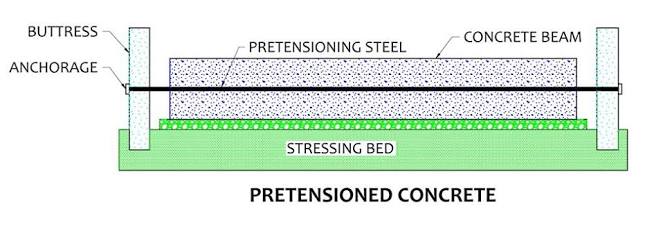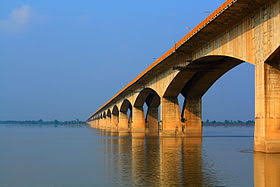Pre stressed concrete (PSC) is concrete in which internal stresses are developed in a predetermined manner such that the stresses induced due to external loading gets balanced with these internal stresses of concrete. This is generally achieved by tensioning the reinforcing steel.
Concrete in its normal state has a high amount of compressive strength. However, compared to its compressive strength, concrete has almost no tensile strength. Therefore, if normal concrete is used to build the slabs, it would sag under the compressive pressure of the weight upon it, and eventually cracks and crumble. To remedy this weakness in concrete, the method of pre-stressing is applied
PSC was introduced in nineteenth century, and has widened its range of use since then. Now-a- days it is used in wide range of structures. It increases the performance of concrete and allows a longer span with reduced thickness of structure.
In PSC, high strength concrete is combined with high strength steel such that full section is effective in resisting tension and compression. In India, use of pre-stressed concrete spreads over years. The first PSC Bridge was built in 1948 under the Assam Rail Link Project.
A pre-stressed concrete structure is different from a conventional reinforced structure due to the application of an initial load on the structure prior to its use.
Need of Pre-stressing in Concrete Member
Concrete is weak in tension and strong enough in compression. It can take compressive stresses up to 50N/mm2 and tensile strength of 2.5N/mm2. In normal reinforced concrete, the steel bars are provided where tensile strength of concrete has to be increased. But under usual working conditions, concrete develops minute cracks as the steel yield i.e. undergoes strain.
This defect of reinforced concrete is reduced by the use of pre-stressed concrete. A pre-stressed concrete is a usual concrete member but tendons (it is a stretched element in a concrete member to pre-stress to the concrete) are provided to introduced necessary prestressing forces, however, once the crack is developed in pre-stressed concrete it behaves same as reinforced concrete.

Advantages of Pre-stressed Concrete
Pre-stressed concrete offers more advantages than reinforced concrete, which are as follows;
1) The cross-section is utilized more efficiently in pre-stressed concrete as compared to reinforced concrete.
2) Pre stressed concrete allows for a longer span.
3) Pre-stressed concrete members offer more resistance against shear force.
4) Considering same depth of concrete member, a pre stressed concrete member is stiffer than the reinforced concrete member under working loads.
5) The use of higher strength concrete and high strength steel results in smaller cross-section.
6) Pre stressing in concrete improves the ability of concrete member to absorb impact loads more efficiently.
7) It has good ability to resist repeated working loads as compared to reinforced concrete.
8) For longer span structure pre-stressed concrete is more economical than the reinforced concrete.
9) It has capacity to completely recover from the effect of overloading.
10) It has better fatigue strength.
11) Self weight of the concrete structure is reduced.
12) It helps in rapid and reliable construction.
Disadvantages of Pre-stressed Concrete
1) Use of pre-stressed concrete needs expertise and special equipment.
2) It requires quality control and inspection.
3) It can be costly for small scale in initial cost.
Cover requirement in Pre-stressed concrete:
IS 1343 specifies a minimum clear cover of 20mm for pre-tensioned member and 30mm for post tensioned member. If pre-stressed concrete member is exposed to aggressive environment then this requirement is increased by 10mm.
Sources of Pre-stressing
- Mechanical Devices:
These are the devices which generally consist of mechanical equipments (screw jacks, geared transmission along with pulley blocks, weights with or without lever transmission and wire winding machine )to introduce tension in tendons. These are generally used in factories where components of pre-stressed concrete are manufactured on large scale. - Hydraulic Devices:
These are several hydraulic jacks patented by engineers [Freyssinet, Magnel, Gifford Udall and Baur Leonhardt] during their work on pre-stressing of concrete. - Thermal Devices:
Tension is provided by heating the wire, and anchoring them before casting the concrete in moulds. This method is called as thermo-electric pre-stressing. - Chemical Devices:
The pre-stressing is imparted here due to expanding cements by controlled variation of curing condition; it induces tensile forces in tendons and compressive forces in concrete.
Types of tensioning in Pre-Stressed Concrete
1. Pre-Tensioning
It is a type of pre stressing in which steel wires (tendons) are stretched before the placement of concrete.

2. Post-tensioning
It is type of pre-stressing in which tension is applied to tendons after concrete is hardened.

3. Internal Pre-stressing
Tendons when provided within the concrete volume, it is known as internal pre-stressing
4. External Pre-Stressing
Tendons when provided outside of concrete volume, it is known as external pre-stressing.
Some Important Pre-Stressed Concrete Structures in India
1) Ganga bridge, Patna: It is the longest pre-stressed concrete bridge in the world with a total length of 5575m, consisting of pre-stressed concrete girders of span 121.65m.

2) Gomti Aqueduct, U.P. : It is longest and the biggest aqueduct of India consisting of 9.9m deep pre-stressed concrete girders over a span of 31.8m with weight of each girder being 550 tons .
3) Ball Tank, Mumbai: It is a pre-stressed concrete tank of 4 x 106 liters capacity, constructed for Department of Atomic Energy.
4) Pamban Road Bridge, Tamil Nadu: Also referred as Annai indira road bridge with a span of about 2065m is classic example of use of pre-stressed concrete girders.

 (+91) 7249196273
(+91) 7249196273
